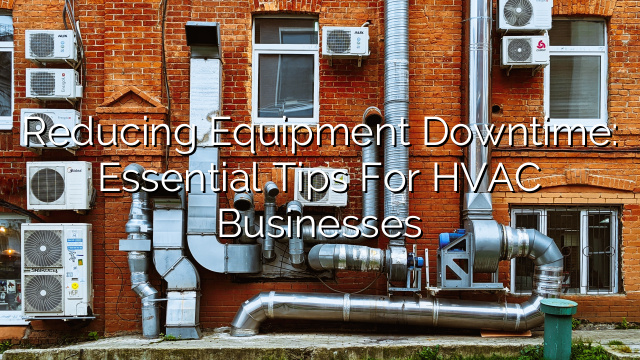Introduction
When you’re in the HVAC business, equipment downtime can be a major headache. It disrupts your workflow, frustrates your customers, and ultimately affects your bottom line. However, with the right strategies in place, you can effectively reduce equipment downtime and keep your business running smoothly. In this article, we will discuss some essential tips for HVAC businesses to minimize equipment downtime and increase productivity.
1. Implement a Preventive Maintenance Program
One of the most effective ways to reduce equipment downtime is by implementing a preventive maintenance program. Regularly inspecting and maintaining your HVAC equipment can help identify and resolve issues before they become major problems.
A preventive maintenance program typically includes tasks like cleaning and lubricating equipment, inspecting electrical connections, checking refrigerant levels, and replacing worn-out parts. By following a preventive maintenance schedule, you can catch potential problems early on and address them quickly, minimizing downtime.
2. Train Your Technicians
Properly trained technicians are the backbone of any HVAC business. By investing in ongoing training and education for your workforce, you can ensure that they have the knowledge and skills needed to handle a wide range of equipment and troubleshooting scenarios.
Regular training sessions can help your technicians stay up-to-date with the latest industry trends, advancements in HVAC technology, and best practices for equipment maintenance and repair. When your technicians are well-trained and equipped with the right tools, they are more likely to resolve issues efficiently and minimize downtime.
3. Maintain an Inventory of Spare Parts
Having an inventory of commonly used spare parts can help you address equipment issues quickly and reduce downtime. Keep track of the parts that frequently need replacement and ensure that you have an adequate supply on hand.
By keeping spare parts readily available, you can avoid delays caused by having to order parts when the need arises. This allows your technicians to complete repairs in a timely manner, reducing equipment downtime and keeping your customers satisfied.
4. Use Remote Monitoring Technology
Remote monitoring technology allows you to keep an eye on your HVAC equipment 24/7, even when you’re not physically present. It involves installing sensors and monitoring devices that can detect abnormalities in equipment performance and send real-time alerts to your smartphone or computer.
With remote monitoring, you can proactively identify issues and take necessary action before they lead to equipment failure or downtime. This technology also provides valuable data on equipment performance and energy usage, helping you identify opportunities for optimization and cost savings.
5. Keep a Detailed Maintenance Record
Maintaining a detailed record of all maintenance activities can provide valuable insights into your equipment’s performance, history, and recurring issues. By documenting each maintenance visit, repair, and replacement, you can spot patterns and identify chronic problems that need attention.
Keeping a maintenance record also helps you schedule preventive maintenance more efficiently, ensuring that no equipment is overlooked or neglected. It also enables you to track the lifespan of individual components and plan for necessary replacements before they fail.
6. Optimize Your Scheduling and Dispatch System
A well-organized scheduling and dispatch system can significantly reduce equipment downtime by ensuring that your technicians reach job sites promptly and efficiently. An optimized system should have the capability to assign tasks based on proximity, availability, and skills.
Investing in scheduling software that integrates with your office systems and technicians’ mobile devices can streamline your dispatch process. This allows you to allocate resources effectively, track job statuses in real-time, and make last-minute adjustments when needed.
7. Maintain Good Communication with Customers
Keeping your customers informed and updated about equipment repairs can go a long way in minimizing frustration and maintaining customer satisfaction. Establish clear communication channels and provide timely updates on repair progress, estimated completion times, and any unforeseen delays.
Regularly check in with your customers after repairs to ensure that everything is functioning properly. Building strong relationships with your customers can not only help minimize equipment downtime but also generate positive reviews and referrals for your business.
FAQs
Q1. What is the cost of implementing a preventive maintenance program?
Implementing a preventive maintenance program can vary in cost depending on the size of your HVAC business and the number of equipment units you have. However, the cost is usually much lower compared to the expenses incurred due to sudden breakdowns and prolonged downtime. Consider the preventive maintenance program as an investment that pays off in the long run.
Q2. How often should preventive maintenance be performed on HVAC equipment?
The frequency of preventive maintenance can vary depending on the manufacturer’s recommendations, the type of equipment, and the usage pattern. In general, it is recommended to perform preventive maintenance at least once or twice a year. However, for high-usage equipment or critical systems, more frequent inspections may be required to minimize downtime.
Q3. Is remote monitoring technology expensive to implement?
The cost of implementing remote monitoring technology can vary depending on the complexity of your setup and the number of sensors required. However, with advancements in technology, remote monitoring systems have become more affordable and accessible for HVAC businesses of all sizes. Consider the long-term benefits and potential cost savings when assessing the investment required.
Q4. How can I ensure that my technicians stay up-to-date with the latest HVAC trends and technologies?
To ensure that your technicians stay up-to-date, consider partnering with HVAC equipment manufacturers, industry organizations, and training institutes. These entities often provide training sessions, webinars, and certifications that can help your technicians expand their knowledge and skills. Encourage your technicians to participate in these training opportunities and provide incentives for continuous education.
Q5. What should I do if I don’t have enough spare parts readily available?
If you find yourself frequently running out of spare parts, consider partnering with reliable suppliers or manufacturers who can provide quick turnaround times for deliveries. Additionally, assess your inventory and identify the parts that are in high demand. Consider stocking up on these parts to minimize delays caused by ordering and shipping.
Q6. How can I improve communication with my customers during equipment repairs?
Invest in customer relationship management software that allows you to track and manage customer communications effectively. Utilize automated notifications and reminders to keep customers informed about repair progress and any delays. Train your staff to communicate clearly and proactively provide updates to customers, addressing any concerns or questions promptly.







